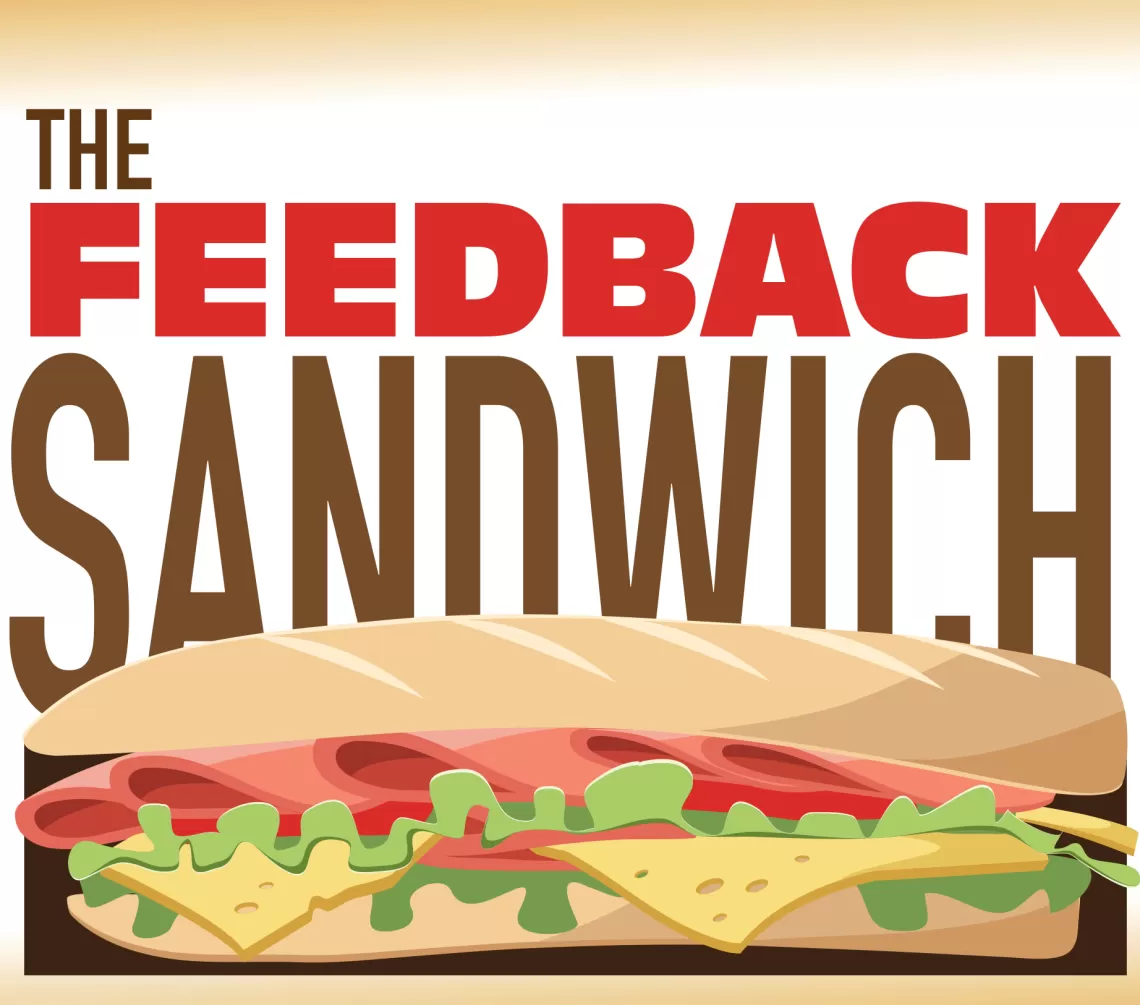
The Feedback Sandwich
Should you be using it?
Guest Blogger: Noell Jankowski
Many leaders report using the “sandwich” method to deliver feedback, and some employees even claim to enjoy receiving it, but what effect does this method have on employee performance? This post will highlight some of the most recent evidence on methods of feedback, and why you may want to reconsider delivering that sandwich.
The Feedback Sandwich
Let’s start with a brief explanation of what a “feedback sandwich” is for those of you who may not be familiar. The term “feedback sandwich” refers merely to a specific sequence of statements: a positive feedback statement, a constructive feedback statement, and then another positive feedback statement.

Many believe that the feedback sandwich is a great way to deliver constructive feedback; the positive comments at the beginning and end of the sequence are thought to minimize the performers’ emotional responses to hearing that they need to correct something. It is true that this method might be more preferred by the person delivering the feedback (and even by some who receive this type of feedback), but what impact does the sandwich method actually have on the receiver’s future performance? If our goal as the feedback deliverer is to improve the individual’s future performance, this is the question we should ask ourselves. Here is the good news: researchers in the field of Organizational Behavior Management (OBM) have already asked and researched this question. The bad news, you ask? Well, if you have been using this method, you might want to take a closer look at the impact it’s having on the performer’s future performance. Research has suggested that the sandwich method may be one of the more ineffective methods of delivering feedback.
Why is this important for you?
Well, regardless of your position at work, you will probably find yourself in situations in which you want to influence the performance of others, whether it is your employee, coworker, manager, or customer. Many of us already know the power that our words can have on other people’s motivation and behavior, but we don’t always know how to use that power strategically. The key to being strategic in how you use your words lies in understanding the impact that your words are having on another person’s behavior. This knowledge can help you say the right thing, in the right way, at the right time, to get the effect you want. When it comes to the fast-paced, ever-changing world at work, it is essential to ensure that the way you are providing feedback is the most efficient and effective way of improving performance.
What Literature is Telling us
Previous research has found that giving feedback to an employee as often as possible, daily or weekly, has a more significant effect on performance than feedback that is delivered less often. However, blending different types of feedback can be contradictory and can undermine the effectiveness of the individual components of the feedback (Choi, Johnson, Moon, & Oah, 2018). In other words, when positive and constructive feedback are sandwiched together, the behavior that the individual received constructive feedback on might be less likely to change when she performs it again in the future. Additionally, the behavior that she received positive feedback on might not occur again in the future. Another finding from the research is that ending your positive feedback with a constructive feedback statement may do more harm than good; this research has suggested it could decrease the future performance of the task (Henley & Reed, 2015). It is recommended that the more feedback that is provided before the constructive feedback, the less likely the individual is to pay attention to the constructive feedback (Henley & Reed, 2015).
 So, what should you do then? As you may have guessed, the research suggests that you should stick with one type of feedback at a time, because it will improve an individual’s performance more quickly than mixed-feedback statements will (Choi et al., 2018). Here is how you might do this: shortly after the individual performs the task, deliver positive comments related to the aspects that the individual performed well. If you notice that some elements of the performance could be improved, ask him to perform the task again (or wait until his next opportunity to perform it, if you know when it is). Shortly before he begins to perform the task again, deliver the constructive feedback. You might consider saying something like, “I want you to try doing (insert aspect of the task here)like this,” rather than telling the individual that he did it wrong the last time. Recent evidence suggests that you can provide feedback after the performance or before the next performance; both will still be effective at impacting future performance (Henley & Reed, 2015). If you are concerned with how your employees will receive the feedback when providing only constructive feedback, rest assured that research has suggested it will still improve performance (Choi et al., 2018). However, be sure when delivering constructive feedback that it is coming across to your employees as supportive and sincere; help them identify what needs to change and suggest something they may not have tried yet.
So, what should you do then? As you may have guessed, the research suggests that you should stick with one type of feedback at a time, because it will improve an individual’s performance more quickly than mixed-feedback statements will (Choi et al., 2018). Here is how you might do this: shortly after the individual performs the task, deliver positive comments related to the aspects that the individual performed well. If you notice that some elements of the performance could be improved, ask him to perform the task again (or wait until his next opportunity to perform it, if you know when it is). Shortly before he begins to perform the task again, deliver the constructive feedback. You might consider saying something like, “I want you to try doing (insert aspect of the task here)like this,” rather than telling the individual that he did it wrong the last time. Recent evidence suggests that you can provide feedback after the performance or before the next performance; both will still be effective at impacting future performance (Henley & Reed, 2015). If you are concerned with how your employees will receive the feedback when providing only constructive feedback, rest assured that research has suggested it will still improve performance (Choi et al., 2018). However, be sure when delivering constructive feedback that it is coming across to your employees as supportive and sincere; help them identify what needs to change and suggest something they may not have tried yet.
Four Important Points to Remember
- Make sure to provide performance feedback to your employees as often as possible (weekly, or even daily).
- Stick with providing feedback that is either positive or constructive; try to separate the two.
- Whether you provide feedback just after the individual performs or just prior to his/her next opportunity to perform may not matter as much as initially thought, just be sure to provide the feedback, and remember points 1 and 2!
The sandwich method of feedback may sound appealing; however, it may undermine the impact your feedback has on the individual’s performance. Limit your feedback to either positive or constructive feedback and observe the effect it has!
 Noell Jankowski is currently completing her second year in the ABA + OBM Master’s program at Florida Tech. She received her B.S. in Psychology from Central Michigan University in 2016. Noell has worked in the field of behavior analysis for three years, and has experience working in a basic EAB research laboratory, and working in clinical settings with children diagnosed with autism. Most recently, she has been working as an instructional design and OBM intern at ABA Technologies, Inc. while working toward her certification to become a BCBA. She is interested primarily in applying behavior analysis to the workplace to assist in improving employee performance and motivation.
Noell Jankowski is currently completing her second year in the ABA + OBM Master’s program at Florida Tech. She received her B.S. in Psychology from Central Michigan University in 2016. Noell has worked in the field of behavior analysis for three years, and has experience working in a basic EAB research laboratory, and working in clinical settings with children diagnosed with autism. Most recently, she has been working as an instructional design and OBM intern at ABA Technologies, Inc. while working toward her certification to become a BCBA. She is interested primarily in applying behavior analysis to the workplace to assist in improving employee performance and motivation.
REFERENCES:
Henley, A. J., & DiGennaro Reed, F. D. (2015). Should you order the feedback sandwich? Efficacy of feedback sequence and timing. Journal of Organizational Behavior Management, 35(3-4), 321-335.
Choi, E., Johnson, D. A., Moon, K., & Oah, S. (2018). Effects of positive and negative feedback sequence on work performance and emotional responses. Journal of Organizational Behavior Management, 1-19.


